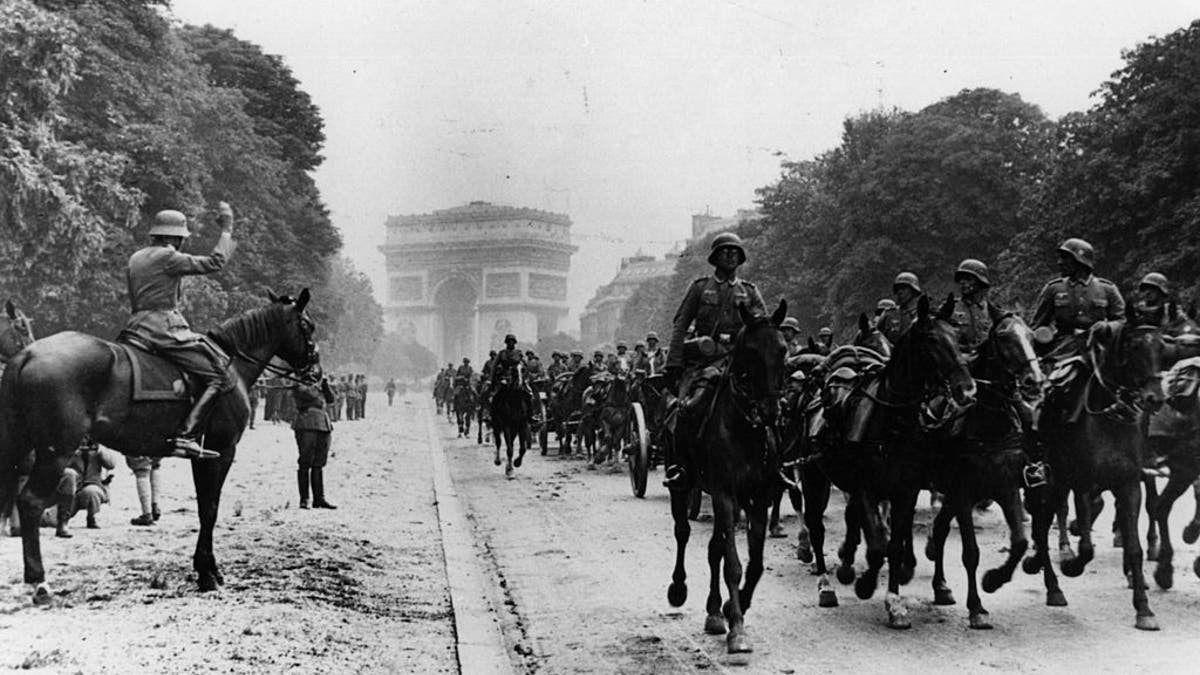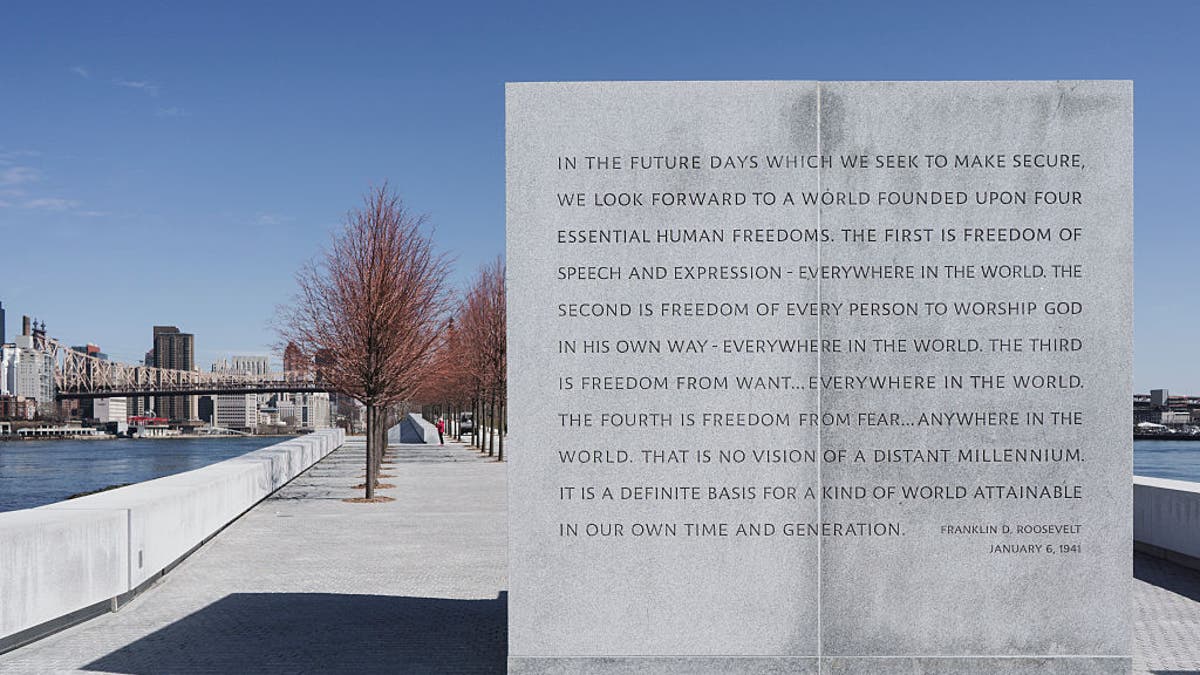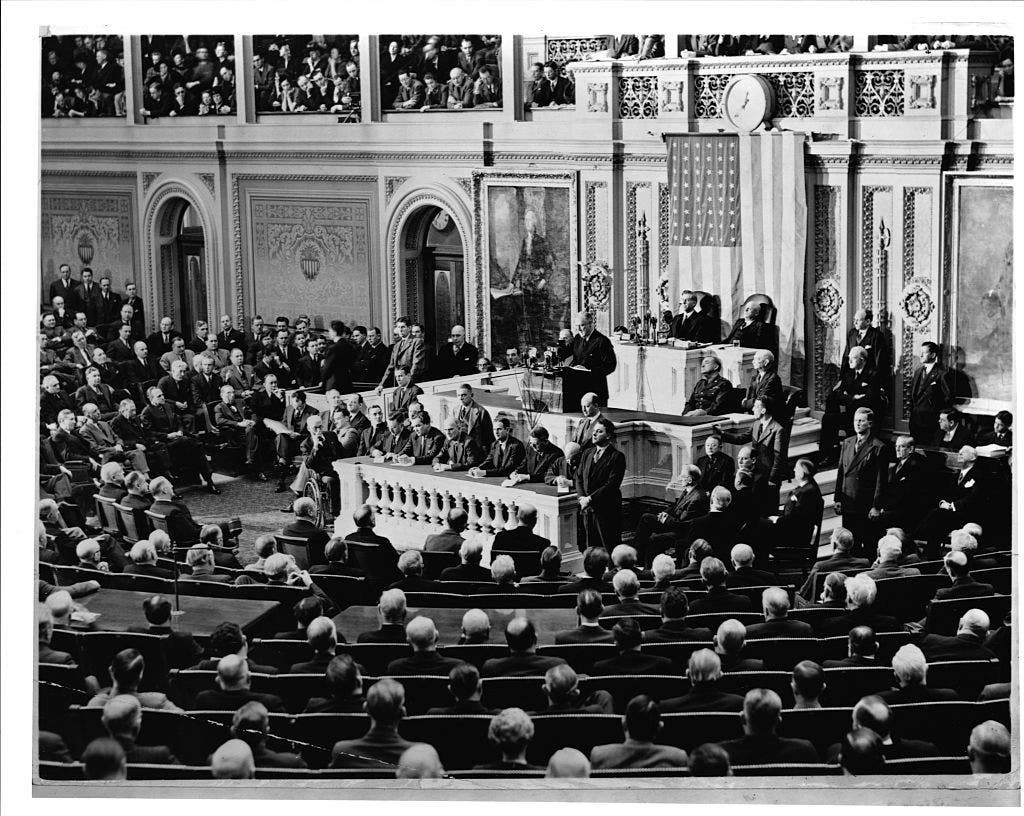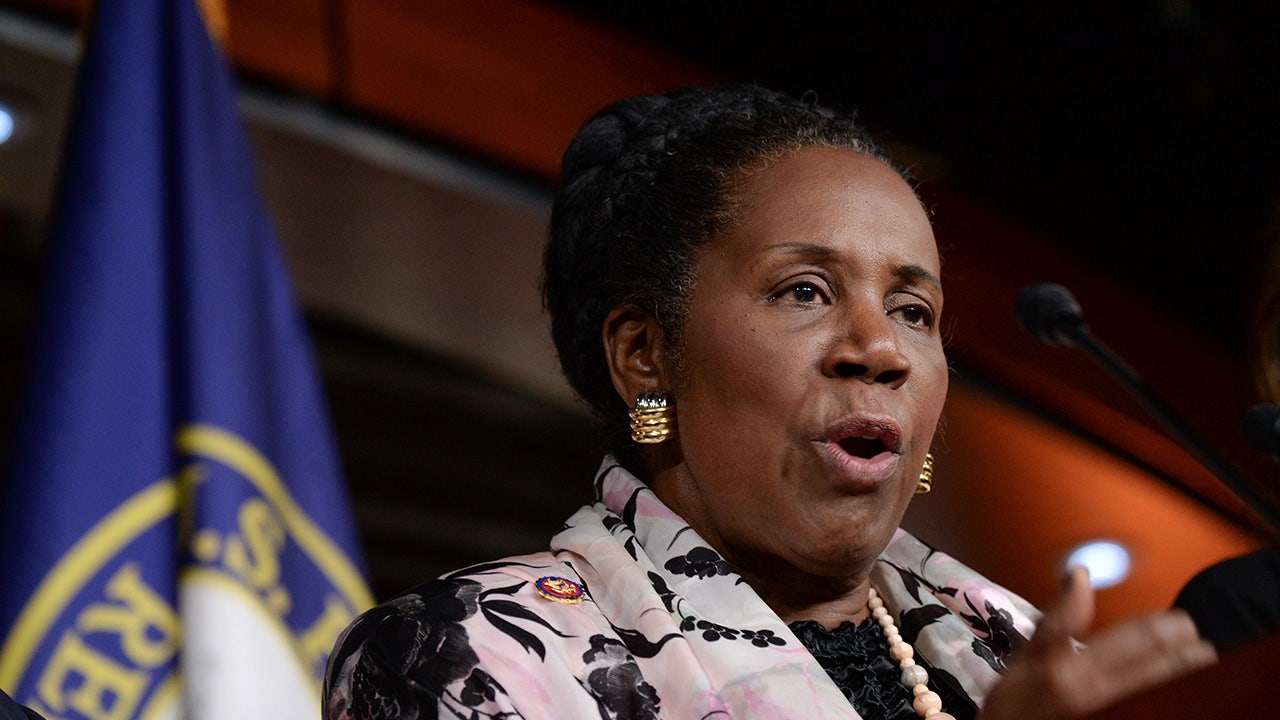President Franklin Delano Roosevelt made a dramatic call to the American people to protect and defend four universal human ideals in his State of the Union address on this day in history, January 6, 1941.
The speech came amid the terrifying and seemingly unstoppable march of military tyranny around the world.
Now known as the Four Freedoms speech, FDR’s remarks that day served as a spiritual call to arms for the American people who, before the year was out, would be thrust violently into World War II.
ON THIS DAY IN HISTORY, JANUARY 5, 1933, CONSTRUCTION OF THE GOLDEN GATE BRIDGE BEGINS AMONG GREAT FANFARRY
Roosevelt cited freedom of speech, freedom of religion, freedom from want and freedom from fear, while war consumed much of the rest of the planet.
More than 400,000 Americans would give their lives for the cause of those Four Freedoms in every corner of the planet at the end of World War II in 1945.
President Franklin Delano delivers his State of the Union address to a joint session of Congress on January 6, 1941. It would be remembered as his “Four Freedoms” speech. (Library of Congress/Corbis/VCG via Getty Images)
“The armed defense of democratic existence is now being bravely waged on four continents,” Roosevelt told both houses of Congress in his eighth State of the Union address.
“If that defense fails, the entire population and all the resources of Europe, Asia, Africa and Australasia will be dominated by the conquerors.”
By early 1941, Nazi Germany had conquered most of Europe and North Africa.
It was pulverizing London and other major British cities through daily air raids and was about to launch a deep incursion into the Soviet Union.
FDR’s Four Freedoms speech served as a spiritual call to arms for the American people.
By early 1941, Imperial Japan had occupied or conquered the Korean Peninsula, Taiwan, Southeast Asia, and much of mainland China, committing horrendous atrocities along the way.
Japan would launch a massive multi-front offensive in Asia and the Pacific before the end of the year, including its December 7 attack on Pearl Harbor.
FDR’s speech delved into the core values of the Declaration of Independence.

July 1940: German artillery marches along the Champs-Élysées from the Arc de Triomphe in Paris, after taking the city. (Hulton Archive/Getty Images)
The president was preparing the American people for their inevitable entry into global conflict by appealing to the values most deeply held by the nation.
The speech included a more practical call to congressional leaders and the nation to ramp up wartime industries in preparation for the coming conflict.
ON THIS DAY IN HISTORY, JANUARY 4, 1965, LJB PROMOTES ‘GREAT SOCIETY’ UTOPIA IN STATE OF THE UNION ADDRESS
The Four Freedoms, Roosevelt said, “are not a vision of a distant millennium. It is a definitive basis for a kind of world attainable in our own time and generation. That kind of world is the very antithesis of the so-called new order of tyranny that the dictators intend to create with the explosion of a bomb”.
Roosevelt’s speech inspired a series of “Four Freedoms” paintings by artist Norman Rockwell, which he produced in 1942 after the United States entered the war.

Norman Rockwell’s “Save Free Speech, Buy War Bonds” poster. (Corbis via Getty Images)
His richly human images powerfully captured the values that propelled the United States into World War II. Rockwell’s paintings are still commonly seen on social media today, and often serve as memes or to illustrate political causes.
One popular image, “Freedom of Speech,” shows a man dressed in work clothes, obediently approaching to be heard at a town meeting. Another, “Freedom from Want,” shows a family happily awaiting a hearty Christmas dinner.
Roosevelt cited freedom of speech, freedom of religion, freedom from want and fear as universal human ideals.
Rockwell was already illustrating images for the war effort on behalf of the U.S. government, but “he wanted to do more,” writes the Normal Rockwell Museum.
“He decided that he would illustrate Roosevelt’s four freedoms. While reflecting on this, Rockwell, by chance, attended a town meeting where a man stood up among his neighbors and expressed an unpopular opinion. That night Rockwell woke up realizing that he could “painting freedoms. Best from the perspective of your own hometown experiences using simple, everyday scenes, such as your own hometown gathering.”

Franklin D. Roosevelt Four Freedoms Park on Roosevelt Island in New York. The park is the first monument dedicated to the former president in his home state of New York. Located on the southern tip of Roosevelt Island in New York City, it is the last work of the late Louis I. Kahn, an iconic architect of the 20th century. The park celebrates the Four Freedoms. (James Leynse/Corbis via Getty Images)
The paintings were published by the Saturday Evening Post in February 1943.
They quickly became iconic images that captured the purpose of war for millions of Americans in a few home images.
CLICK HERE TO SUBSCRIBE TO OUR LIFESTYLE NEWSLETTER
“The paintings were a phenomenal success,” says the Norman Rockwell Museum.
“After publication, the Post received 25,000 requests for reprints.”
The paintings quickly became iconic images that captured the purpose of the war for millions of Americans in a few home images.
The government initially rejected his offer to use them for the war effort. But the overwhelming popularity inspired a sudden change of heart.
Federal officials adopted the illustrations as part of the national effort to sell war bonds and stamps to finance the march to victory.
“There is only one speech in American history that inspired a multitude of books and movies, the creation of its own park, a series of paintings by a world-famous artist, a prestigious international award, and a United Nations resolution on human rights.” Paul M. Sparrow wrote on behalf of the Franklin D. Roosevelt Presidential Library and Museum.
CLICK HERE TO GET THE FOX NEWS APP
“The words of the speech are engraved in marble at Four Freedoms Park on Roosevelt Island in New York, are displayed in the paintings of Norman Rockwell, inspired the Four Freedoms International Prize, and are the basis of the Universal Declaration of Human Rights adopted by the United Nations in 1948.”
Following the victory of the United States and its allies in World War II, former military powers Germany, Japan, and many other nations around the world adopted constitutional republics.
Millions of people could now enjoy for the first time the freedoms expressed by Roosevelt on January 6, 1941, at the cost of hundreds of thousands of American lives.
For more lifestyle articles, visit www.foxnews.com/lifestyle.












